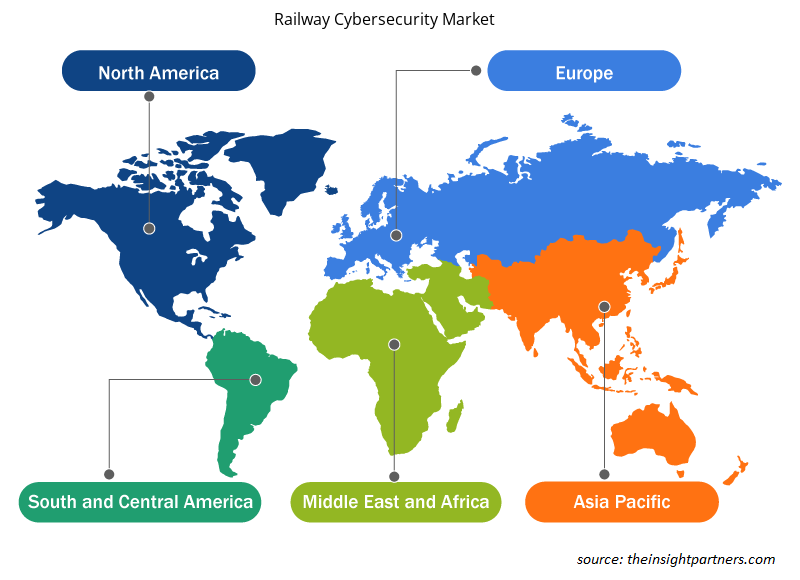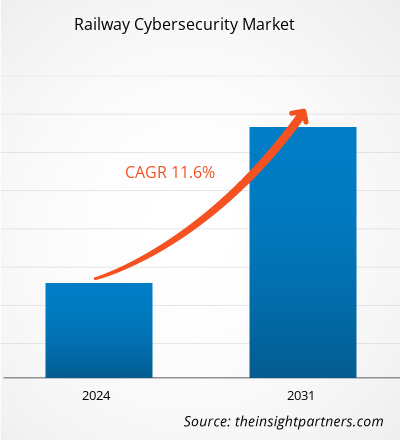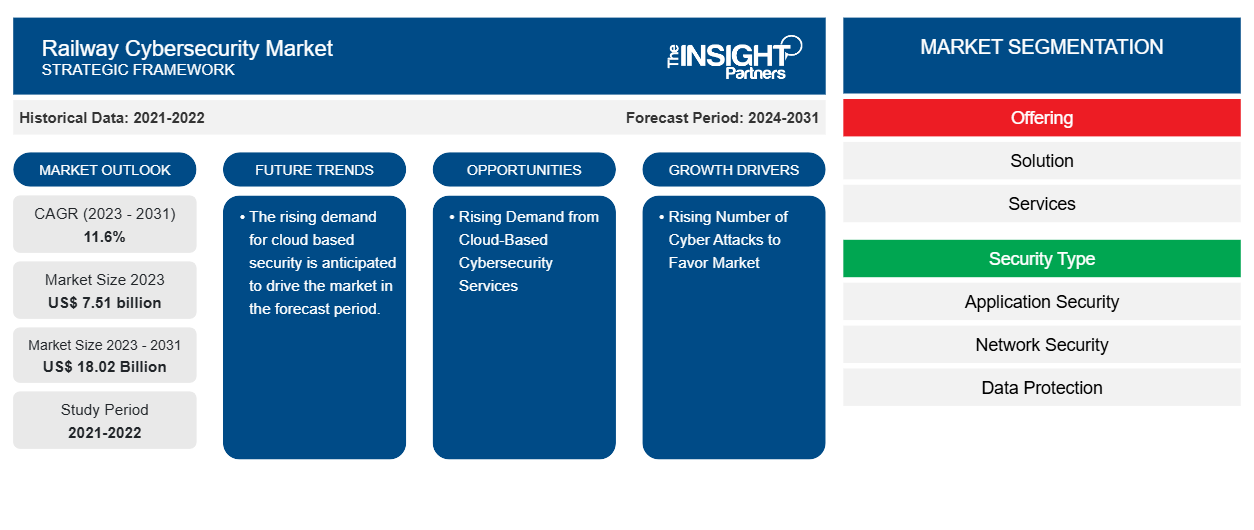Si prevede che la dimensione del mercato della sicurezza informatica ferroviaria raggiungerà i 18,02 miliardi di dollari entro il 2031, rispetto ai 7,51 miliardi di dollari del 2023. Si prevede che il mercato registrerà un CAGR dell'11,6% nel periodo 2023-2031. Il crescente numero di attacchi informatici e la crescente adozione di soluzioni di mobilità intelligente nelle ferrovie saranno probabilmente i principali driver e trend del mercato.
Analisi del mercato della sicurezza informatica ferroviaria
Il mercato della sicurezza informatica ferroviaria sta vivendo una crescita significativa a livello globale. Questa crescita è attribuita al crescente numero di attacchi informatici e alla crescente adozione di soluzioni di mobilità intelligente nelle ferrovie. Inoltre, le crescenti leggi e normative sulla sicurezza informatica e la crescente domanda di servizi di sicurezza informatica basati su cloud sono i fattori che si prevede guideranno la crescita del mercato della sicurezza informatica ferroviaria nei prossimi anni.
Panoramica del mercato della sicurezza informatica ferroviaria
La sicurezza informatica nelle ferrovie sta diventando molto importante a causa della crescente dipendenza da sistemi e tecnologie digitali. Man mano che le ferrovie si sono modernizzate, hanno adottato vari sistemi basati su computer per monitorare e controllare le operazioni, dalla segnalazione e gestione dei binari alla gestione dei passeggeri e alla biglietteria. Questa digitalizzazione ha reso i sistemi ferroviari più convenienti ed efficienti per passeggeri e operatori.
Personalizza questo report in base alle tue esigenze
Riceverai la personalizzazione gratuita di qualsiasi report, comprese parti di questo report, o analisi a livello nazionale, pacchetto dati Excel, oltre a usufruire di grandi offerte e sconti per start-up e università
- Scopri le principali tendenze di mercato in questo rapporto.Questo campione GRATUITO includerà analisi di dati che spaziano dalle tendenze di mercato alle stime e alle previsioni.
Driver e opportunità del mercato della sicurezza informatica ferroviaria
Il crescente numero di attacchi informatici favorisce il mercato
Le infrastrutture critiche nelle ferrovie sono sempre più esposte a possibili attacchi informatici. La connettività e l'uso della tecnologia in tutti i settori hanno migliorato il servizio fornito ai cittadini, ottimizzando processi e risorse e migliorando la qualità delle azioni di ciascun operatore. Ma questa connettività ha anche il suo lato oscuro, facilitando le azioni di attori malintenzionati che possono attaccare e interrompere il servizio corrispondente. Il settore deve affrontare diverse minacce informatiche che possono influenzare significativamente le sue operazioni. I principali componenti che gli attacchi informatici potrebbero prendere di mira includono sistemi di controllo e segnalazione, reti di comunicazione e sistemi di gestione del traffico, sistemi di informazione e biglietteria per i passeggeri, nonché infrastrutture di manutenzione e gestione delle risorse.
Crescente domanda di servizi di sicurezza informatica basati sul cloud.Cybersecurity Services.
Si prevede che la crescente domanda di servizi di sicurezza informatica basati su cloud guiderà il mercato nei prossimi anni. Le soluzioni di sicurezza informatica basate su cloud possono aiutare nella gestione e nel monitoraggio automatici dei sistemi di segnalazione ferroviaria. È possibile tracciare lo stato di ogni segnale utilizzando sensori e modificare automaticamente le impostazioni in base alle necessità. Può aiutare a migliorare la produttività e prevenire i problemi prima che si verifichino. Un sensore , ad esempio, noterà immediatamente un problema con un segnale particolare. E sul cloud, verranno apportate modifiche in tempo reale che riguardano solo quel segnale. I treni possono quindi evitare quei segnali senza subire ritardi o interruzioni.cybersecurity services is anticipated to drive the market in the coming years. Cloud-based cybersecurity solutions can aid in the automatic management and monitoring of railway signalling systems. One can track the status of each signal using sensors and automatically change and modify settings as needed. It can assist in enhancing productivity and prevent problems before they occur. A
Analisi della segmentazione del rapporto sul mercato della sicurezza informatica ferroviariaCybersecurity Market Report Segmentation Analysis
I segmenti chiave che hanno contribuito alla derivazione dell'analisi del mercato della sicurezza informatica ferroviaria sono l'offerta, il tipo di sicurezza, la tipologia e l'applicazione.cybersecurity market analysis are offering, security type, type, and application.
- In base all'offerta, il mercato della sicurezza informatica ferroviaria è suddiviso in soluzioni (gestione del rischio e della conformità, crittografia, firewall, antivirus/antimalware, rilevamento/prevenzione delle intrusioni e altri) e servizi. Si prevede che il segmento delle soluzioni detenga una quota di mercato significativa nel periodo di previsione.cybersecurity market is divided into solutions (risk and compliance management, encryption, firewall, antivirus/antimalware, intrusion detection/intrusion prevention, and others) and services. The solution segment is anticipated to hold a significant market share in the forecast period.
- In base al tipo di sicurezza, il mercato della sicurezza informatica ferroviaria è suddiviso in sicurezza delle applicazioni, sicurezza di rete, protezione dei dati, sicurezza degli endpoint e amministrazione di sistema. Si prevede che il segmento della sicurezza delle applicazioni detenga una quota di mercato significativa nel periodo di previsione.cybersecurity market is divided into application security, network security, data protection, endpoint security, and system administration. The application security segment is anticipated to hold a significant market share in the forecast period.
- Per tipologia, il mercato è segmentato in tecnologia operativa (OT) e tecnologia informatica (IT). Si prevede che il segmento della tecnologia operativa (OT) deterrà una quota di mercato significativa nel periodo di previsione.
Analisi della quota di mercato della sicurezza informatica ferroviaria per area geograficaCybersecurity Market Share Analysis by Geography
L'ambito geografico del rapporto sul mercato della sicurezza informatica ferroviaria è suddiviso principalmente in cinque regioni: Nord America, Asia Pacifico, Europa, Medio Oriente e Africa, Sud e Centro America.cybersecurity market report is mainly divided into five regions: North America, Asia Pacific, Europe, Middle East & Africa, and South & Central America.
Il Nord America ha dominato il mercato della sicurezza informatica ferroviaria. Le tendenze di adozione di tecnologie elevate in vari settori della regione nordamericana hanno alimentato la crescita del mercato della sicurezza informatica ferroviaria. Si prevede che fattori come l'adozione crescente di strumenti digitali e l'elevata spesa tecnologica da parte delle agenzie governative guideranno la crescita del mercato della sicurezza informatica ferroviaria nordamericana. Inoltre, una forte enfasi sulla ricerca e sviluppo nelle economie sviluppate degli Stati Uniti e del Canada sta costringendo gli attori nordamericani a portare sul mercato soluzioni tecnologicamente avanzate. Inoltre, gli Stati Uniti hanno un gran numero di attori del mercato della sicurezza informatica ferroviaria che si sono sempre più concentrati sullo sviluppo di soluzioni innovative. Tutti questi fattori contribuiscono alla crescita del mercato della sicurezza informatica ferroviaria nella regione.cybersecurity market. High technology adoption trends in various industries in the North American region have fuelled the growth of the railway cybersecurity market. Factors such as increased adoption of digital tools and high technological spending by government agencies are expected to drive the North American railway cybersecurity market growth. Moreover, a strong emphasis on research and development in the developed economies of the US and Canada is forcing the North American players to bring technologically advanced solutions into the market. In addition, the US has a large number of railway cybersecurity market players who have been increasingly focusing on developing innovative solutions. All these factors contribute to the region's growth of the railway cybersecurity market.
Approfondimenti regionali sul mercato della sicurezza informatica ferroviariaCybersecurity Market Regional Insights
Le tendenze e i fattori regionali che influenzano il Railway Cybersecurity Market durante il periodo di previsione sono stati ampiamente spiegati dagli analisti di Insight Partners. Questa sezione discute anche i segmenti e la geografia del Railway Cybersecurity Market in Nord America, Europa, Asia Pacifico, Medio Oriente e Africa e Sud e Centro America.

- Ottieni i dati specifici regionali per il mercato della sicurezza informatica ferroviaria
Ambito del rapporto sul mercato della sicurezza informatica ferroviaria
| Attributo del report | Dettagli |
|---|---|
| Dimensioni del mercato nel 2023 | 7,51 miliardi di dollari USA |
| Dimensioni del mercato entro il 2031 | 18,02 miliardi di dollari USA |
| CAGR globale (2023-2031) | 11,6% |
| Dati storici | 2021-2022 |
| Periodo di previsione | 2024-2031 |
| Segmenti coperti | Offrendo
|
| Regioni e Paesi coperti | America del Nord
|
| Leader di mercato e profili aziendali chiave |
|
Densità degli attori del mercato della sicurezza informatica ferroviaria: comprendere il suo impatto sulle dinamiche aziendali
Il mercato della sicurezza informatica ferroviaria sta crescendo rapidamente, spinto dalla crescente domanda degli utenti finali dovuta a fattori quali l'evoluzione delle preferenze dei consumatori, i progressi tecnologici e una maggiore consapevolezza dei vantaggi del prodotto. Con l'aumento della domanda, le aziende stanno ampliando le loro offerte, innovando per soddisfare le esigenze dei consumatori e capitalizzando sulle tendenze emergenti, il che alimenta ulteriormente la crescita del mercato.
La densità degli operatori di mercato si riferisce alla distribuzione di aziende o società che operano in un particolare mercato o settore. Indica quanti concorrenti (operatori di mercato) sono presenti in un dato spazio di mercato in relazione alle sue dimensioni o al valore di mercato totale.
Le principali aziende che operano nel mercato della sicurezza informatica ferroviaria sono:
- CAPGEMINI SE
- Cisco Systems, Inc.
- Azienda aerospaziale Collins
- Hitachi, Ltd.
- Azienda: Huawei Technologies Co.
- Società anonima
Disclaimer : le aziende elencate sopra non sono classificate secondo un ordine particolare.

- Ottieni una panoramica dei principali attori del mercato della sicurezza informatica ferroviaria
Notizie e sviluppi recenti sul mercato della sicurezza informatica ferroviaria
Il mercato della sicurezza informatica ferroviaria viene valutato raccogliendo dati qualitativi e quantitativi post-ricerca primaria e secondaria, che includono importanti pubblicazioni aziendali, dati associativi e database. Di seguito sono elencati alcuni degli sviluppi nel mercato della sicurezza informatica ferroviaria:
- Cylus, rinomato leader nelle soluzioni di sicurezza informatica ferroviaria, ha annunciato un traguardo: la sua soluzione di punta CylusOne ha conquistato l'ambito titolo di prima soluzione di sicurezza informatica ferroviaria al mondo a ottenere la prestigiosa certificazione IEC 62443-4-2 al livello di sicurezza 3. (Fonte: sito Web aziendale Cylus, febbraio 2024)
- Strides International Business è pronta a firmare un memorandum d'intesa (MoU) con Egis per la fornitura di servizi di sicurezza informatica nel settore ferroviario. (Fonte: sito web aziendale di Strides International Business, novembre 2023)
Copertura e risultati del rapporto sul mercato della sicurezza informatica ferroviaria
Il rapporto “Dimensioni e previsioni del mercato della sicurezza informatica ferroviaria (2021-2031)” fornisce un’analisi dettagliata del mercato che copre le seguenti aree:
- Dimensioni e previsioni del mercato della sicurezza informatica ferroviaria a livello globale, regionale e nazionale per tutti i principali segmenti di mercato coperti dall'ambito
- Tendenze del mercato della sicurezza informatica ferroviaria e dinamiche di mercato come conducenti, restrizioni e opportunità chiave
- Analisi dettagliata delle cinque forze PEST/Porter e SWOT
- Analisi del mercato della sicurezza informatica ferroviaria che copre le principali tendenze del mercato, il quadro globale e regionale, i principali attori, le normative e i recenti sviluppi del mercato
- Analisi del panorama industriale e della concorrenza che copre la concentrazione del mercato, l'analisi della mappa di calore, i principali attori e gli sviluppi recenti per il mercato della sicurezza informatica ferroviaria
- Profili aziendali dettagliati
- Analisi storica (2 anni), anno base, previsione (7 anni) con CAGR
- Analisi PEST e SWOT
- Valore/volume delle dimensioni del mercato - Globale, Regionale, Nazionale
- Industria e panorama competitivo
- Set di dati Excel
Report recenti
Rapporti correlati
Testimonianze
Motivo dell'acquisto
- Processo decisionale informato
- Comprensione delle dinamiche di mercato
- Analisi competitiva
- Analisi dei clienti
- Previsioni di mercato
- Mitigazione del rischio
- Pianificazione strategica
- Giustificazione degli investimenti
- Identificazione dei mercati emergenti
- Miglioramento delle strategie di marketing
- Aumento dell'efficienza operativa
- Allineamento alle tendenze normative























 Ottieni un campione gratuito per - Mercato della sicurezza informatica ferroviaria
Ottieni un campione gratuito per - Mercato della sicurezza informatica ferroviaria